Gamificación en las aulas

En la entrada de hoy os hablaré un poco de las nuevas tendencias que nos encontramos en las aulas, donde unos pocos intrépidos profesores se están animando a incorporar la gamificación o ludificación en sus clases.
Poco a poco los profesores y centros empiezan a ver la importancia que tiene una aproximación diferente a los alumnos y justo gamificar las clases puede llegar a parcelas de motivación en los alumnos que de otra forma es muy difícil alcanzar.
Una de las principales razones que dan los profesores que se animan a gamificar sus asignaturas, es que ven que no llegan a sus alumnos como antes, que estos desconectan en sus clases.
Cada vez son más los profesores que se animan a compartir sus experiencias e incluso se asocian, un ejemplo de esto lo encontramos en http://gamificatuaula.wixsite.com/ una comunidad de profesores gamificadores que comparten experiencias y recursos.
Es cierto que las experiencias de gamificación en el aula si bien van en aumento todavía son escasas y suelen provenir de iniciativas particulares más que del centro como tal. Esto es lógico dada la novedad de la aproximación y la dificultad de cuadrar las necesidades de cumplir con el currículo oficial establecido y las características de la gamificación. Pero si se prestase algo más de atención por parte de los centros, verían las ventajas que puede aportar esta aproximación.
La Neurodidáctica nos enseña ciertas características del aprendizaje.
- El cerebro aprende cuando se emociona.
Justo una de las cosas que tienen los videojuegos es esa capacidad de emocionar, llevar eso a una gamificación no es sencillo y requiere un trabajo, pero dada la población destino, es mucho más posible crear algo que les pueda llegar y que les emocione si lo comparamos con entornos de formación en empresas.
- El cerebro es un órgano social que mejora el aprendizaje cuando interactúa con otros.
En el aula se producen interacciones, eso es innegable, pero con la gamificación podemos modelarlas o conducirlas para que sean lo más cercanas posible a nuestra necesidad.
- El cerebro aprende haciendo.
Cuantas más oportunidades demos de aprender lo visto en el aula mejor. Con la gamificación podemos generar dinámicas repetitivas para afianzar contenidos en las personas o aproximaciones desde diferentes áreas que mandasen la misma información para que tenga que realizar la misma tarea varias veces. El fin es que el alumno tenga que reiterar en los contenidos que queremos afianzar.
La aproximación a la gamificación en el aula sigue siendo todavía muy poco tecnológica. Basándose en muchas ocasiones en la incorporación de juegos de mesa y gestionando las mecánicas de puntos, logros, medallas y otros, de manera manual, esto genera un problema de gestión y en ocasiones limita el acercamiento a la gamificación.
Con el acceso a través de Apps para móviles y Tablets se pueden lograr mejores herramientas y recursos que sin duda ayudarán a realizar mejores gamificaciones en el aula, y en aquellos centros que por el rango de edad los alumnos puedan tener acceso a una App en su móvil o tablet, ampliaremos aún más el alcance de las mismas.
Las Aulas 2.0 empiezan a ser una realidad, pero en muchas ocasiones no se hace un uso del potencial que tienen y la gamificación es una forma de pasar al concepto de Educación 2.0.
———————
Gamification in the Classrooms.
Today I will talk about the new education trends that we can find in classrooms, where a few brave teachers are trying to incorporate gamification or ludification in their classrooms.
Little by little teachers and centers begin to see the importance of having a different approach to students and gamifying the classrooms can reach motivations areas in students who otherwise would be very difficult to achieve.
One of the main reasons that teachers give when they use gamification at classroom is that they felt that they didn’t reach their students, that they were disconnected from classroom.
More and more teachers are willing to share their experiencies and even create help groups, We can find and example here http://gamificatuaula.wixsite.com/ a community of gamifiers teachers who share experiences and resources.
I have to say that the gamification experiences in the classroom, although increasing, they still being a few and they usually came from private initiatives than from a plan of the centre. This is quite logical given the novelty of this approach, the difficulty of following the established curriculum and the characteristics of gamification. But centers should pay more attention to this in order to see the advantages that this approach can bring to them.
Neurodidactic teaches us some characteristics of learning.
- The brain learns when it gets emotional.
One of the things that you can find in videogames is the ability to thrill, to take that to a gamification is not an easy task and requires quite amount of work, but given the target population, it is a better way to reach them and be able to excite them than the usual training environments in companies.
- The brain is a social organ that improves learning when interacting with others.
In the classroom you can find interactions, that is undeniable, but with gamification we can model them or lead them to be as close as possible to our need.
- The brain learns by doing.
The more opportunities we give to learn what is seen in the classroom, the better. With gamification we can generate repetitive dynamics to strengthen some content in people or create approaches from different areas that send the same information that makes the user to perform the same task several times. The purpose is to make student to rework in the contents that we want to strengthen.
The approach to gamification in the classroom is still very little technological. Based on many occasions in the incorporation of table games and managing the mechanics of points, achievements, medals and others, manually, this generates a management problem and sometimes limits the approach to gamification.
With access through Apps for mobiles and Tablets you can have better tools and resources that will undoubtedly help to make better gamifications in the classroom, and in those centers that by the age range the students can have access to an App in their Mobile or tablet, we can extend even more the reach of them.
Classrooms 2.0 begin to be a reality, but in many occasions school centers they do not make use of the potential that they have and the gamification is a way to pass to the concept of Education 2.0.



